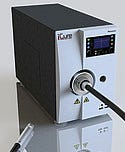April 14, 2010
|
The ICure AS200 fiber-optic system provides heat by IR radiation, reducing curing times significantly. |
Anyone in the healthcare industry will tell you that medical devices will continue to shrink. But how do you join miniature parts together while ensuring accurate adhesion and preventing the formation of partially uncured bond lines? IRphotonics Inc. thinks that its iCure system is the answer.
Developed as an alternative to oven curing of adhesives, the iCure AS200 is a fiber-optic system that provides heat by infrared (IR) radiation. A clean heat-source technology, it reduces curing times from tens of minutes to seconds while protecting temperature-sensitive substrates, according to the company. In addition to lowering cure times by as much as 75%, the system can perform in-line curing.
"This is a small-footprint system that emits high thermal energy," says Ruben Burga, IRphotonics's vice president of sales. "This energy is directed onto the curing site via a proprietary mid-IR fiber light guide, or fiber bundle. Because this is photonics energy, it is light energy across a broad bandwidth that works at the glue-absorbing wavelengths."
The system is suitable for thermal-curing and other radiation-curing glues, most of which contain a built-in catalyst. When light in the mid-IR wavelength hits such glues, molecules absorb the light and start vibrating. The friction from this vibration heats up the glue from within until the catalyst begins to act. Focusing energy from the system's lamp box into the light guide, the unit can cure not only parts that are visible to light but also those that are invisible to light. This process works by converting radiation, or light energy, from the light guide into conductive energy when it impacts the part, providing on-demand curing, Burga comments. The system can also perform on-demand heating, generating temperatures in excess of 300°C or as low as 30°, 40°, or 50°C.
"The biggest challenge facing the development of this technology was collecting light and channeling it through a light guide to the application site," Burga remarks. Devising a glass light guide that can transmit IR energy was difficult because standard optical fibers transmit only up to 2 µm in wavelength. "A unique material frequently used in the spectroscopy world, our optical fiber is transparent from the UV all the way to the mid-IR range," Burga explains. "Because it is transparent above 2 µm, any wavelength above that to the mid-IR will be transmitted efficiently."
Electrical contacts and electrical or fiber-optic devices affixed to the ends of catheters and probes are often not UV transmissive, complicating the curing process. "When you make devices that end up inside the brain or heart, they have to be 100% cured," Burga says. That's where iCure comes in--its IR-based technology can penetrate down to the bond line, ensuring precise assembly."
Another challenge was developing a high-power IR energy source. To achieve this, the company obtained a lamp capable of producing a tiny plasma spot of energy with large IR content. "Our lamp," Burga notes, "is essentially a miniature sun that concentrates all the energy into a single focus that is then carried to the curing site."
IRphotonics Inc.
Hamden, CT
www.icure-irphotonics.com
About the Author(s)
You May Also Like



